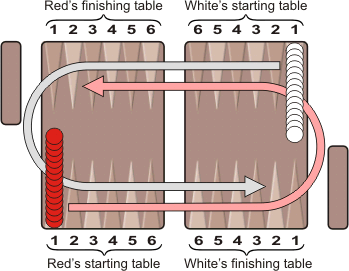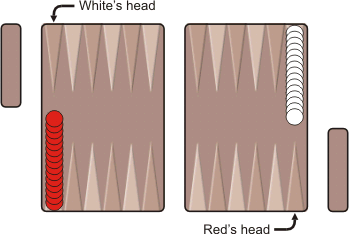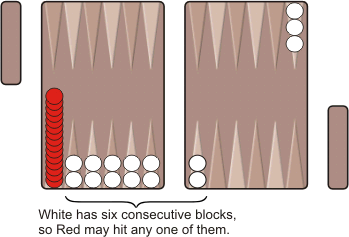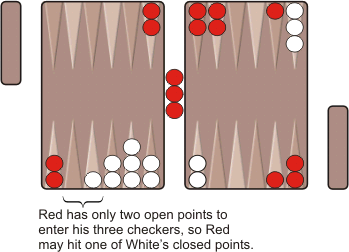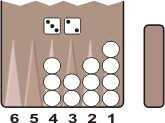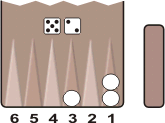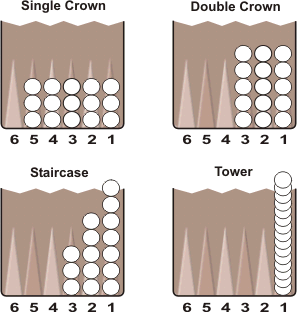![[Backgammon Galore!]](/gif/GaloreButton.gif)
|
|
Backgammon Variants Setup: Each player starts with fifteen checkers on the rightmost point of the far side of the board, so the players start at diagonally opposite corners from each other. They move in the same direction, counterclockwise, around the board.
Object: The object of the game is to move all of your checkers around the board to your finishing table, and then bear off all your checkers, or score a "handsome" win, or win "jan." To start: Each player rolls one die. The player who rolls the lower number goes first. After the first game, the loser of the previous game goes first. Movement: The roll of the dice indicates how many points, or pips, the player is to move his checkers. The following rules apply:
Entering from the bar: Any time you have one or more checkers on the bar, your first obligation is to reenter those checker(s) into your starting table. You enter a checker by moving it to an open point corresponding to one of the numbers on the rolled dice. If you are able to enter some but not all of your checkers, you must enter as many as you can then give up the remainder of your turn. Restrictions on closing points: You are not allowed to pile more than one checker on a point on the opponent's side of the board with one exception: The leftmost point on the opponent's side of the board is called your "head" and you may pile as many checkers as you want onto that point.
Even your starting point has this restriction. Even though you start with more than one checker on this point, you are not allowed to add checkers to the point during the game. This makes entering checkers much more difficult than in regular backgammon because now your own checkers create blocks in addition to any closed points created by your opponent. Hitting closed points: A closed point (one having two or more of your checkers on it), is normally immune to attack. However, there are two stiuations when a closed point may be hit:
When a closed point is hit, all of the checkers on that point are sent to the bar. There is one exception to the above rule: If a player only has one checker left on the board, he may no longer hit any closed point. Bearing off: Once you have moved all fifteen of your checkers to your finishing table, you may begin bearing off. To bear off a checker you must roll a number equal to or greater than the point number of your farthest back checker. If a number you roll is not high enough bear off your farthest back checker, then you must use that number to move a checker forward (if possible).
You may not unnecessarily waste pips when bearing off. This means you should always bear off a checker where possible rather than use a smaller number to move that checker forward.
If one of your checkers is hit during bearoff, it must be reentered in your starting table and brought around the board again to your finishing table before you can resume bearing off. Handsome win: You do not need to bear off all your checkers to win. A player can also win if he manages to arrange all his checkers in his finishing table into one of the four patterns listed below:
As soon as a player bears off a checker, he loses his chance to get a handsome win.
Monk: If a player wins the game when the opponent has one or more checkers on the bar, he scores an extra point. This is called winning with monk. The term "monk" also applies to the defeated player (who becomes monk) and to the checkers on the bar (monk checker or monk checkers). Jan: A player wins jan if he sends so many checkers to the bar that it is impossible for the opponent to reenter them all. (Remember that a player cannot put more than one checker on a point on the opponent's side of the board.) So a player wins jan if the opponent has more checkers on the bar than the number of open points in the opponent's starting table. Forced jan: If a player wins jan by hitting a closed point and sending two or more checkers to the bar, this is called a "forced jan" and scores extra. End of game: The game is over as soon as either player bears off his last checker, scores a handsome win, or wins jan. A player who can finish the game is not obligated to do so if he can make an otherwise legal move. However, the game must end once it has reached one of the final positions described above, even in the middle of a turn. Scoring: Swedish Tables can end in seven different ways. Five of these games can additionally be won with monk. The table below shows the number of points the winner receives for each type of win.
Swedish Tables is usually played in matches consisting of three, five, or seven games. If the match is tied after the required number of games, the player who scored the highest-value game wins the match, or, if it is still tied, the player who scored the second-highest game wins, etc.
References
|
![]()
Backgammon Galore : Variants

